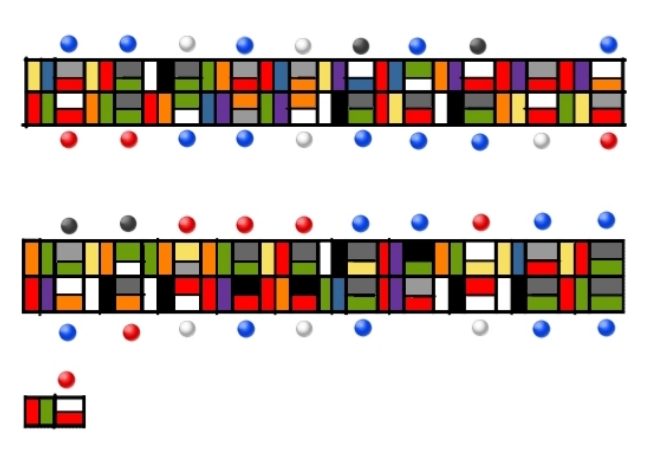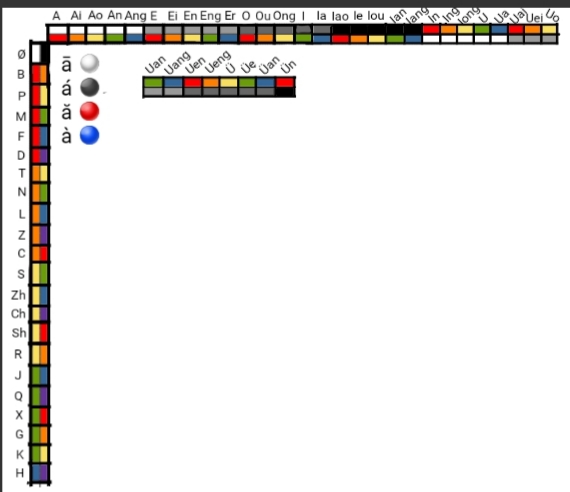It looks like you're using an Ad Blocker.
Please white-list or disable AboveTopSecret.com in your ad-blocking tool.
Thank you.
Some features of ATS will be disabled while you continue to use an ad-blocker.
6
share:
In the interest of a change of pace.
I have always like codes and ciphers. From one time pads (number station codes), the Navajo code talkers, to The Zodiac Killer's possibly intentionally misspelled ones. And because I just watched something about him, I created a code that is totally out of the box and based on the phonetic sounds of language broken into syllables. No sinister killer messages though.
Here it is:

I really dont expect anyone to care enough to try to figure it out, but will withhold the key anyway. And someone might like the challenge.
I will post the answer if my weird boredom killing thread garners any interest. Probably won't and I'll post it anyway.
* I honestly couldn't figure out where to post this thread. Move if needed.
I have always like codes and ciphers. From one time pads (number station codes), the Navajo code talkers, to The Zodiac Killer's possibly intentionally misspelled ones. And because I just watched something about him, I created a code that is totally out of the box and based on the phonetic sounds of language broken into syllables. No sinister killer messages though.
Here it is:

I really dont expect anyone to care enough to try to figure it out, but will withhold the key anyway. And someone might like the challenge.
I will post the answer if my weird boredom killing thread garners any interest. Probably won't and I'll post it anyway.
* I honestly couldn't figure out where to post this thread. Move if needed.
edit on 21-2-2023 by Degradation33 because: (no reason
given)
a reply to: Degradation33
Yes!!!
This puzzle reminds me of an old game I used to play called "Queries and Theories". Sadly, no one seemed to enjoy it as much as I did.
But it had "patterns as semantics" structure deduction skill angle....
As I look at your example I wonder if I'm too old to even try to solve it... It is difficult to approach (in my mind) without some hint or other... but hey, I'll give it a shot...
problem is... you'll probably grow old yourself waiting for my solution...
Yes!!!
This puzzle reminds me of an old game I used to play called "Queries and Theories". Sadly, no one seemed to enjoy it as much as I did.
But it had "patterns as semantics" structure deduction skill angle....
As I look at your example I wonder if I'm too old to even try to solve it... It is difficult to approach (in my mind) without some hint or other... but hey, I'll give it a shot...
problem is... you'll probably grow old yourself waiting for my solution...
edit on 2/21/2023 by Maxmars because: (no reason
given)
a reply to: Degradation33
Interesting, but I can't solve it.
Maybe a word search first and we'll work our way up?
Interesting, but I can't solve it.
Maybe a word search first and we'll work our way up?
Should have probably gave hints.
It's transliterated through a foreign language.
Each two successive boxes contain a single syllable. The first box is an initial, the second box is the final, and the dot is a tonal marker.
There are 21 initials, 38 finals. (Two ommitted for redundancy)
Based on a writing system developed in the 20th century.
And I dont think anyone wants to learn that, so here it is. You can do it without being able to speak the language but it would probably take forever.
This cryptogram seemed better yesterday, now it just feels pretentious. It's also really hard to find the reverse translation of Pinyin to English
So here is the key.
The code's key is a pictoral adaptation of The Mandarin Pinyin Chart. Dots over every second box represents tonal markers.

Transcribed it says:
Zhè shì yīgè fēicháng fùzá de dàimǎ
(This is a very complex code)
Nǐ bù huì qīngyì pòyì tā
(You won't easily decipher it)
Kěnéng rúguǒ nǐ shǐyòng diànnǎo
(Possibly if you use a computer)
Zhè shì dài yǒu yīndiào biāojì de yīnyì mìmǎ.
(This is a transliterated cryptogram with tonal markers)
It's transliterated through a foreign language.
Each two successive boxes contain a single syllable. The first box is an initial, the second box is the final, and the dot is a tonal marker.
There are 21 initials, 38 finals. (Two ommitted for redundancy)
Based on a writing system developed in the 20th century.
And I dont think anyone wants to learn that, so here it is. You can do it without being able to speak the language but it would probably take forever.
This cryptogram seemed better yesterday, now it just feels pretentious. It's also really hard to find the reverse translation of Pinyin to English
So here is the key.
The code's key is a pictoral adaptation of The Mandarin Pinyin Chart. Dots over every second box represents tonal markers.

Transcribed it says:
Zhè shì yīgè fēicháng fùzá de dàimǎ
(This is a very complex code)
Nǐ bù huì qīngyì pòyì tā
(You won't easily decipher it)
Kěnéng rúguǒ nǐ shǐyòng diànnǎo
(Possibly if you use a computer)
Zhè shì dài yǒu yīndiào biāojì de yīnyì mìmǎ.
(This is a transliterated cryptogram with tonal markers)
edit on 21-2-2023 by Degradation33 because: (no reason given)
originally posted by: Degradation33
Should have probably gave hints.
It's transliterated through a foreign language.
Each two successive boxes contain a single syllable. The first box is an initial, the second box is the final, and the dot is a tonal marker.
There are 21 initials, 38 finals. (Two ommitted for redundancy)
Based on a writing system developed in the 20th century.
And I dont think anyone wants to learn that, so here it is. You can do it without being able to speak the language but it would probably take forever.
This cryptogram seemed better yesterday, now it just feels pretentious. It's also really hard to find the reverse translation of Pinyin to English
So here is the key.
The code's key is a pictoral adaptation of The Mandarin Pinyin Chart. Dots over every second box represents tonal markers.
Transcribed it says:
Zhè shì yīgè fēicháng fùzá de dàimǎ
(This is a very complex code)
Nǐ bù huì qīngyì pòyì tā
(You won't easily decipher it)
Kěnéng rúguǒ nǐ shǐyòng diànnǎo
(Possibly if you use a computer)
Zhè shì dài yǒu yīndiào biāojì de yīnyì mìmǎ.
(This is a transliterated cryptogram with tonal markers)
Very cool.
And Whooooosh....that's the sounds of that going right over my head.
Wow!
a reply to: MykeNukem
You do need some knowledge of Mandarin to do this. Especially with Y and W represented as Ø.
I figured since the actual cold war is The USA (and allies) vs. China I should at least learn Mandarin to try to be like Eric Cartman and stop their world takeover. What is secret Chinese invasion plans, I forget?
Tonal languages suck. I got entirely through the free part of the app I downloaded and could compose sentences and pass the exams, but retained little of the character composition or recognition. Repeated words. Primarily retaining recognition of the words in pinyin. Hearing it, it's too fast and has too many sounds that blur together like "J" and "Zh", not to mention the final and tone.
I gave up. F Chinese.
I wonder if even a Chinese speaker would outright recognize syllable and tones represented in the code.
Anyway, this was for fun, and deemed interesting enough to share. Although I feel it comes off like, "Oh look at me and my awesome Mandarin code!"
You do need some knowledge of Mandarin to do this. Especially with Y and W represented as Ø.
The letters "y" and "w" are not included in the table of initials in the official pinyin system. They are an orthographic convention for "i", "u" and "ü" when no initial is present. When "i", "u" or "ü" are finals and no initial is present, they are spelled "yi", "wu", and "yu", respectively.
I figured since the actual cold war is The USA (and allies) vs. China I should at least learn Mandarin to try to be like Eric Cartman and stop their world takeover. What is secret Chinese invasion plans, I forget?
Tonal languages suck. I got entirely through the free part of the app I downloaded and could compose sentences and pass the exams, but retained little of the character composition or recognition. Repeated words. Primarily retaining recognition of the words in pinyin. Hearing it, it's too fast and has too many sounds that blur together like "J" and "Zh", not to mention the final and tone.
I gave up. F Chinese.
I wonder if even a Chinese speaker would outright recognize syllable and tones represented in the code.
Anyway, this was for fun, and deemed interesting enough to share. Although I feel it comes off like, "Oh look at me and my awesome Mandarin code!"
edit on 21-2-2023 by Degradation33 because: (no reason given)
a reply to: Degradation33
Anyway, this was for fun, and deemed interesting enough to share. Although I feel it comes off like, "Oh look at me and my awesome Mandarin code!"
Nah, there's geeks here that love this stuff. I'm surprised no one has commented.
Way above my paygrade, lol.
I do find cryptic methods of storing information interesting though.
edit on 2/21/2023 by MykeNukem because: eh?
new topics
-
Bizarre Labour Party Tic Toc Video Becomes Even More Embarrassing
Regional Politics: 7 hours ago
top topics
-
The elephant in the room (wearing a hoodie)
US Political Madness: 14 hours ago, 14 flags -
Dr. Demento
Music: 14 hours ago, 6 flags -
Bizarre Labour Party Tic Toc Video Becomes Even More Embarrassing
Regional Politics: 7 hours ago, 4 flags -
Potter to WHU
World Sports: 13 hours ago, 2 flags
active topics
-
Los Angeles brush fires latest: 2 blazes threaten structures, prompt evacuations
Mainstream News • 270 • : xuenchen -
Judge rules president-elect Donald Trump must be sentenced in 'hush money' trial
US Political Madness • 71 • : WeMustCare -
The elephant in the room (wearing a hoodie)
US Political Madness • 26 • : xuenchen -
Its Looking Like Schiff - Vindman - Ciaramella Conspired to Impeach President Trump.
Political Conspiracies • 188 • : WeMustCare -
Statements of Intent from Incoming Trump Administration Members - 2025 to 2029.
2024 Elections • 60 • : WeMustCare -
Trump's idea to make Canada the 51st US state: 'Potential is massive'
Mainstream News • 155 • : DaydreamerX -
Gravitic Propulsion--What IF the US and China Really Have it?
General Conspiracies • 38 • : DaydreamerX -
What Is 'Quad Demic'? Mask Mandate Returns In These US States
Diseases and Pandemics • 45 • : Scratchpost -
Encouraging News Media to be MAGA-PAF Should Be a Top Priority for Trump Admin 2025-2029.
Education and Media • 93 • : WeMustCare -
Advice for any young Adult .
General Chit Chat • 18 • : Cre8chaos79
6
